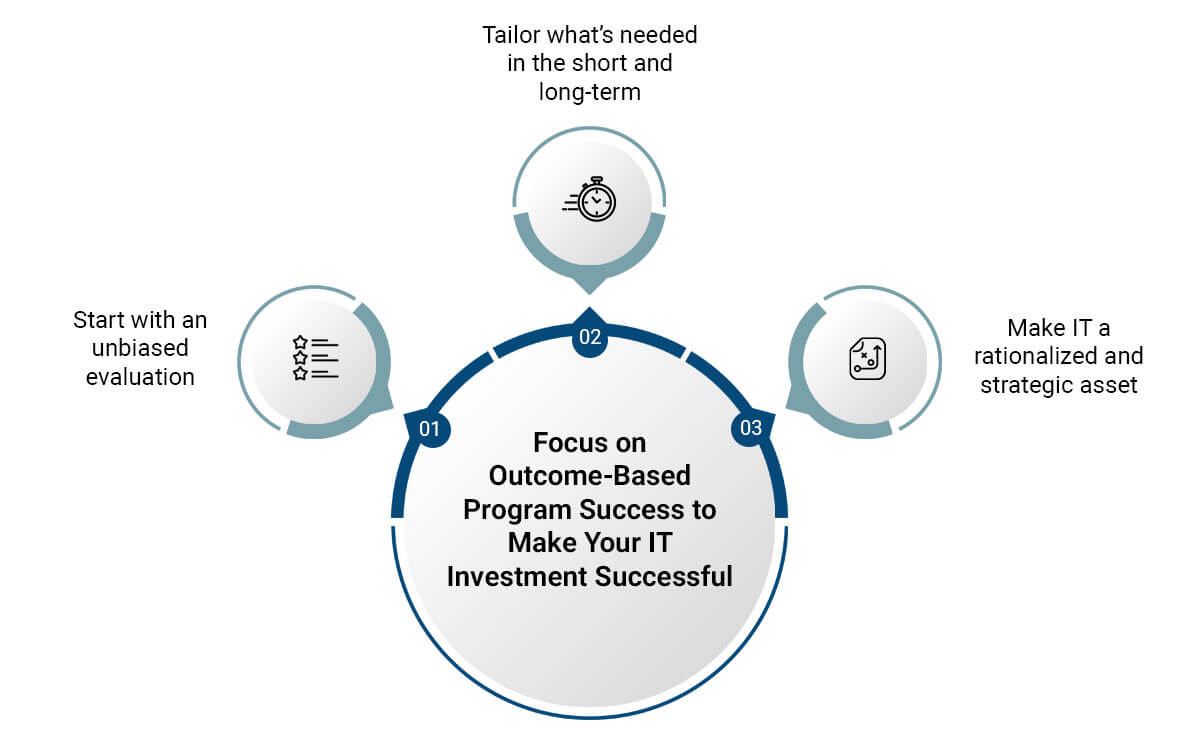For a long time, people have seen technology as a cost center. However, the recent changes brought about by the pandemic have proven that technology is not only an enabler but also an accelerator for measured achievement. The impact of technology investment can be quantified in terms of business outcome evolution – and meaningful technology adoption shows immediate results.
Identifying the “Real” Challenges
Most clients come to us with a technical problem. However, with a determined consulting approach, we uncover the truth of what customers are actually seeking. On most occasions, clients are seeking to (1) achieve unique business outcomes as well as (2) the mitigation of risks, be it compliance, cyber threats, governance, competition of IT talent, liability, obsolescence, or multi-supplier management. Customers are determined to realize larger (outcome) goals including, but not limited to:

Note that the larger goals as well as the capabilities that help achieve these goals MUST be measured, tracked, and validated across the customer’s current and desired future state.
Changing the “Outlook” towards “Outsourcing” Is Important
Even before approaching us, many of these organizations attempt to make considerable investments in their technology organization to achieve these goals – but fail to see authentic and impactful results. A recent Forrester TEI™ (Total Economic Impact) study, commissioned by Synoptek, illustrates how organizations can achieve and measure their goals by leveraging strategic sourcing services and how it is a game-changer for other organizations to model.

Step 1: Start with an Unbiased Evaluation
The specific client, discussed in the Forrester TEI study, could not advance its technology environment despite spending over 5% of its annual revenue on IT-related expenses. So, when Synoptek first engaged, we evaluated, validated, and documented the client’s current and desired future state within our time-tested and proven Capability Maturity Model. We also studied the gaps/obstacles that stood in the way of achieving the desired future state. Our initial assessment allowed us to conclude that the client was between a maturity level of 0 and 1, which meant they had an outdated and discernible IT strategy towards meaningful KPIs or ROI while seeing IT as an “inefficient cost center”. Overall, the organization was struggling to maintain a stable technology environment for its employees. The employee productivity was low, and there were growing concerns regarding cybersecurity threats that further impeded day-to-day activities.

Client’s progress on the Synoptek’s Capability Maturity Model
Step 2: Tailor What’s Needed in the Short and Long-Term
Our next step was to design tailored services offering to help the client modernize and optimize their IT environment quickly and, in the long run, position technology to drive sustainable business results. We provided 31 strategic sourcing services to this client – to fill gaps with their thought leadership, infrastructure, resiliency, innovation initiatives, skills gaps, and risk mitigation. We continuously aligned our approach to achieving short-term and long-term goals.

Strategic sourcing services that Synoptek provided to the client
Step 3: Make IT a Rationalized and Strategic Asset
At Synoptek, we believe that as companies move away from the concept of ‘IT as a cost center’ towards ‘IT as a rationalized and strategic asset,’ the impact of technology on defined, measurable, and realized business outcomes becomes evident quickly. However, to move away from the concept of “IT as a cost center”, organizations need to rethink their technology outsourcing model. When companies partner with a service provider that looks at their technology organization as an enabler and creates a systematic, long-term, and holistic plan to take it to the next level of maturity instead of “trying to just fix it” with only short-term solutions – half the battle is won!
The traditional outsourcing approach doesn’t work anymore as it focuses on the inputs – the services and capabilities – that a technology partner provides. However, as companies move towards making IT a rationalized and strategic asset, they focus on the outcome of the engagement and investment. The latter approach – strategic (outcome) sourcing – means the service provider continuously evaluates the company’s initiatives and alignment of the milestones into computed business and technology results.
How Outcome-Based Approach Delivered Tangible Results for the Client
Synoptek moved the client, discussed in the Forrester TEI™ study, from Level 0-1 of our Capability Maturity Model to Level 2 in just 90 days. More importantly, based on our work over ten months, the Forrester team forecasted a 360-degree shift in how the client was conducting their business and reported the following economic impact on their overall business:
- Increase in revenue by $2,934,847 over three years.
- Employee productivity increase by 161 hours per year.
- Savings from operating efficiency increase from leveraging Synoptek shared services by over $1.5 million.
- Savings from accelerated run time and minimized downtime by $4,134,890 over three years.
We shifted their goal post and achieved tangible business results by simply creating a thoughtful long-term plan and a meaningful technology adoption strategy – and constantly evaluating and measuring the results of our actions and aligning them to the defined goals.
Key Takeaways from the TEI™ Study
The key findings in the study highlight the success in advancing the level of maturity in technology and increasing revenues, productivity, and operational efficiency while reducing overall IT expenses by simply making the client engage with services differently. Strategic sourcing outpaces in-house deployment across net present value, ROI, time-to-market, and agility while reducing inherent risks. Three key takeaways from this project are:
- Companies that invest in technology and strategic sourcing evolve from “IT as a cost center” to “a rationalized asset” capable of measuring actual contributions to each business unit.
- Challenges such as IT resilience, legacy infrastructure, impending risks, lack of data insights, and skilled resources can be overcome in less than 180 days.
- The shift from “solution” to “outcome-based” programs provides exact milestones and valued measures of success to executives and company shareholders.



